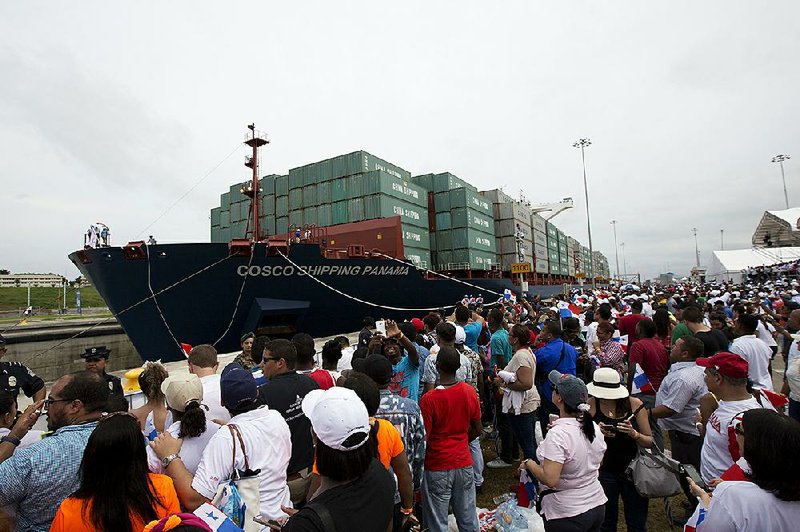PANAMA CITY -- Under exploding fireworks and alongside waving flags, a Chinese ship carrying more than 9,000 containers on Sunday entered the newly expanded locks that will double the Panama Canal's capacity.
Several tugboats pulled the Cosco Shipping Panama into the new locks at Agua Clara under a cloudy sky in Colon province, about 50 miles north of the capital.
"This is the route that unites the world," Panamanian President Juan Carlos Varela said.
"This new transit route is the tip of the iceberg in making Panama once again the logistic center of the Americas," canal administrator Jorge Luis Quijano said as the ship headed for the Pacific Ocean. "And it represents a significant opportunity for the countries of the region to improve their infrastructure, increase their exports."
Thousands of Panamanians who began gathering before dawn to witness the inauguration of the canal's expansion waved the national flag as the band struck up a song.
"It's a one-time experience, a great achievement," said Felicia Penuela, a housewife from Colon province. "Panama is showing the world that even though it is a small country it can do great things."
Nearly two years late because of construction delays and labor strife, the $5.25 billion project formally launched with the transit of the 158-foot-wide, 984-foot-long, Chinese-owned container ship. It's one of the modern class of mega-vessels that will now be able to use the canal.
With 30,000 people and eight foreign heads of state expected to attend the daylong festivities, officials were bullish.
"There is evidence that the Panama Canal, with this expansion, is an important player not only for regional maritime commerce but worldwide," said Oscar Bazan, the Panama Canal Authority's executive vice president for planning and commercial development. "The canal is a winning bet. [Clients] will benefit from saving not only time but also money, because the canal is a route that shortens distance."
However, the party comes during a lull in global shipping due to the drop in oil prices, as well as an economic slowdown in China, which is the canal's second-largest customer, and other factors that have hit the waterway's traffic and income.
While authorities anticipate increasing commerce between Asia and ports on the U.S. East Coast, doubts remain that not all those ports are ready to handle the New Panamex-class cargo ships, which are about 50 feet wider and 230 feet longer than Panamex ships. Net cargo volume through the canal from the U.S. East Coast toward Asia fell 10.2 percent in 2015, according to official statistics. Meanwhile, the Suez Canal in Egypt recently lowered tariffs by up to 65 percent on large container carriers in an attempt to keep its traffic.
"It's important to remember that the canal does not create demand. The canal opens the route. Supply and demand on a world level is what will decide whether the Panama Canal will really bring more volume or not," said Antonio Dominguez, a general manager for global shipping leader Maersk Line, which moves about 14.2 percent of world commerce. "What is certain is that the current canal has maxed out."
Maersk was among the shipping companies that have reduced passages through the Panama Canal, although Dominguez said the company is considering a return.
Since the canal was handed over from U.S. control at the end of 1999, the waterway has generated about $10 billion in direct income for the Central American nation and is responsible for about 40 percent of its gross domestic product, factoring in related economic activity. Some 35 to 40 vessels transit the waterway each day, and the canal is estimated to handle about 6 percent of world maritime commerce.
Panama began the expansion nearly a decade ago. Originally planned to open in late 2014 around the waterway's centennial, the new locks can accommodate ships that carry up to three times the cargo of those previously able to use the canal.
The United Group for the Canal, the Italian- and Spanish-led consortium that spearheaded construction, handed the project over Friday, although a series of claims are still pending for presumed cost overruns of more than $3 billion.
Paul Bingham, a shipping economist at Boston-based Economic Development Research Group, predicted that the canal expansion's global impact will be small.
"The proportion of world trade that could plausibly use the Panama Canal is constrained by the geography of the world's population, resource endowments and production regions," Bingham said. "There is very little a larger canal can influence at the margin to induce shifts in the geography of world trade, even through potential reductions in costs of shipping a variety of commodities to, from and within the Americas."
Information for this article was contributed by Peter Orsi of The Associated Press.
A Section on 06/27/2016
